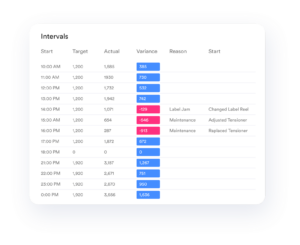In the dynamic world of lean manufacturing, Short Interval Control(SIC) has emerged as a crucial methodology. In this piece, we explore the elements of Short Interval Control and demonstrate how TrakSYS, our industry-leading manufacturing execution system(MES), enables manufacturers to effectively implement and utilize SIC for substantial operational enhancement.
What is Short Interval Control
Short Interval Control is a structured performance management technique that breaks production hours into scheduled intervals, usually ranging from 1 to 4 hours each. Each interval has clear baselines, goals, and issue resolution and escalation guidelines.
Roles in SIC: Manager, Supervisor, Operator
Under the SIC paradigm, there are three distinct roles, each with varying responsibilities:
- Managers: Establish the process, lead initial meetings, provide training, and audit the process.
- Supervisors: Take over meeting leadership, motivate and engage operators.
- Operators: Identify and implement shop floor improvement actions.
SIC Meetings
SIC meetings are conducted on the plant floor, are usually 10 minutes or less, and see department leaders:
- Look back at the previous interval—what went well, what didn’t?
- Look forward to the upcoming interval and determine if priorities have shifted due to the events of the previous interval.
- Prioritize the goal for the next interval, ensuring that the determined goal is measurable and attainable.
Actionable SIC Strategies
During SIC intervals, plant-floor teams focus on specific actions that enhance production. This includes—when possible—small scale fixes to identified issues, stabilizing measures, preparation for upcoming events, and improvements in throughput or equipment, processes, or best practice documentation. Actions beyond the scope of the interval or requiring additional resources are escalated for higher-level review.
TrakSYS and SIC: an Example
As evidenced by the previous sections, data plays a pivotal role in SIC, requiring the accurate, timely collection of operational metrics for effective decision-making. Imagine a scenario where equipment malfunctions within a SIC interval. Since additional team members will be needed to get the asset back online, this event technically falls outside the scope of SIC and would need to be addressed in the SIC meeting. However. In this scenario, our operator is using TrakSYS.
The Benefits of SIC
The short-term benefits of SIC encompass not only immediate operational efficiencies but also enhanced transparency and faster issue resolution. That, in turn, leads to reduced downtimes and increased productivity. Long-term benefits extend to cultivating a culture of continuous improvement, increased employee engagement through proactive problem-solving, and sustained enhancements in overall production quality and reliability.
TrakSYS for Short Interval Control(SIC)
 TrakSYS plays a pivotal role in enhancing Short Interval Control by providing a dynamic and intuitive platform that elevates production and performance management. Acting as the”single source of truth,” the platform is not only a place where SOPs and best practices documents can be stored, but it is also a place where team members—from across departments—can communicate, view real-time, contextualized production information, execute tasks, and access the role-specific information they need to further their organization’s continuous improvement initiatives. For more information on how TrakSYS enables lean manufacturing, click here.
TrakSYS plays a pivotal role in enhancing Short Interval Control by providing a dynamic and intuitive platform that elevates production and performance management. Acting as the”single source of truth,” the platform is not only a place where SOPs and best practices documents can be stored, but it is also a place where team members—from across departments—can communicate, view real-time, contextualized production information, execute tasks, and access the role-specific information they need to further their organization’s continuous improvement initiatives. For more information on how TrakSYS enables lean manufacturing, click here.
FAQs
Short Interval Control is a structured process management technique that breaks production hours into scheduled intervals, usually ranging from 1 to 4 hours each. Each interval has clear baselines, goals, and issue resolution and escalation guidelines.

